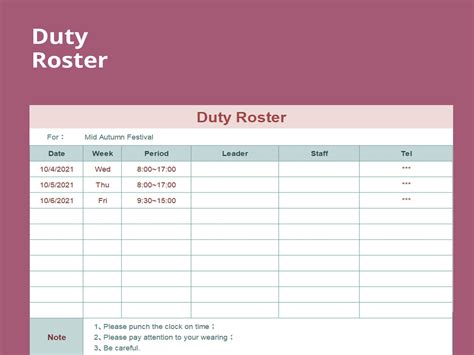

2025 Duty Roster Optimization: VS. Traditional Formats
Introduction

As the healthcare industry continues to evolve, so too must the systems used to manage its workforce. The traditional duty roster, while once effective, is no longer able to meet the complex demands of modern healthcare. This article will discuss the challenges of the traditional duty roster and present an innovative solution to optimize staff scheduling and improve patient care.
Challenges of Traditional Duty Rosters
Traditional duty rosters often suffer from the following challenges:
- Manual Processes: Rosters are often created manually, which can be time-consuming and prone to errors.
- Lack of Flexibility: Once created, duty rosters are often inflexible, making it difficult to accommodate sudden changes in patient demand or staff availability.
- Inefficient Staffing: Traditional rosters often rely on guesswork or intuition, leading to inefficient staffing levels and potential under- or over-staffing.
- Employee Dissatisfaction: Fixed and inflexible duty rosters can lead to employee dissatisfaction, as they may not align with their preferences or family commitments.
Innovative Duty Roster Optimization
To address these challenges, a new approach to duty roster optimization is needed. This approach utilizes data analytics, artificial intelligence (AI), and machine learning (ML) to create automated, data-driven, and optimized rosters.
Key Features of Optimized Rosters
- Data-Driven Scheduling: Optimizing duty rosters using data analytics ensures that staffing levels are based on real-time patient demand, historical trends, and staff availability.
- AI-Powered Shifts: AI algorithms analyze employee profiles, preferences, and skills to create personalized shift assignments that maximize employee satisfaction and optimize staff utilization.
- Machine Learning Forecasting: ML models predict future patient demand and staff availability, allowing for proactive planning and adjustments.
- Real-Time Adjustments: Optimized duty rosters are constantly updated in response to unforeseen changes, such as staff absences or fluctuations in patient volume.
Benefits of Optimized Duty Rosters
Optimized duty rosters offer numerous benefits to hospitals and healthcare organizations, including:
- Improved Patient Care: Optimized staffing levels ensure that patients receive the necessary care when they need it.
- Increased Staff Satisfaction: Personalized shift assignments and flexibility improve employee morale and reduce turnover rates.
- Operational Efficiency: Data-driven scheduling and real-time adjustments minimize overtime costs and optimize resource allocation.
- Reduced Risk: Automated roster creation eliminates errors and ensures compliance with labor regulations.
Table 1: Comparison of Traditional vs. Optimized Duty Rosters
| Feature | Traditional Roster | Optimized Roster |
|---|---|---|
| Process | Manual | Automated |
| Flexibility | Limited | High |
| Staffing Efficiency | Suboptimal | Optimized |
| Employee Satisfaction | Low | High |
Implementation Considerations
Implementing optimized duty rosters requires careful planning and collaboration among stakeholders. Here are some key considerations:
- Data Collection: Collect comprehensive data on patient demand, staff availability, and employee preferences.
- Technology Adoption: Invest in a robust roster optimization software that leverages data analytics, AI, and ML.
- Stakeholder Engagement: Gain buy-in from hospital leadership, managers, and staff to ensure successful adoption.
- Training and Support: Provide adequate training and ongoing support to staff on the new system.
Future Trends and Innovation
The optimization of duty rosters is an ongoing area of research and innovation. Here are some emerging trends to watch for:
- Predictive Analytics: Advanced algorithms will enhance forecasting capabilities to predict future demand and staffing requirements more accurately.
- Employee Engagement: Optimized rosters will incorporate employee feedback and preferences to foster greater engagement and job satisfaction.
- Integration with EHRs: Rostering software will integrate with electronic health records (EHRs) to access real-time patient data and automate scheduling.
Conclusion
Optimizing duty rosters using data analytics, AI, and ML is a game-changer for hospitals. By addressing the challenges of traditional rosters, optimized rosters enhance patient care, increase staff satisfaction, improve operational efficiency, and reduce risks. As the healthcare industry continues to evolve, optimized duty rosters will become essential for delivering high-quality care in a cost-effective and efficient manner.
References
- American Hospital Association. (2021). Hospital Workforce Statistics. https://www.aha.org/statistics
- National Health Service. (2022). Workforce Planning and Rostering. https://www.england.nhs.uk/workforce/planning-and-rostering
- World Health Organization. (2020). Health Workforce Data: A Global Overview. https://www.who.int/hrh/statistics/hrh_global_overview_report/en










